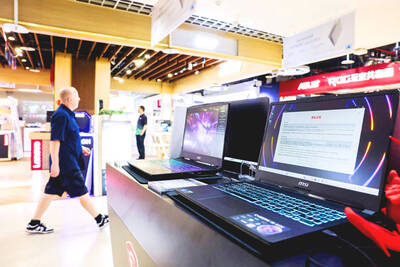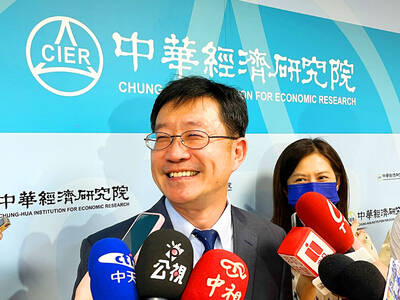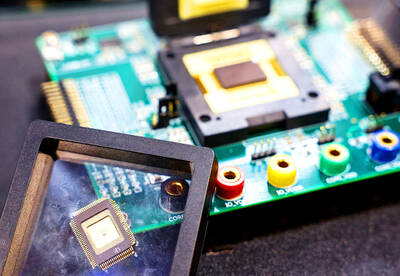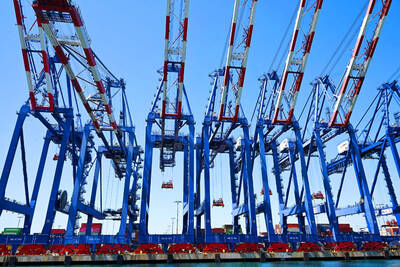The Chung-Hua Institution for Economic Research (CIER, 中經院) raised its economic growth forecast for the year yesterday to 4.67 percent, up from the previously estimated 4.16 percent, on closer economic ties with China, which would boost domestic demand.
“In the second half [of this year], a pickup of domestic demand will contribute more than export growth to the nation’s economy,” Wang Lee-rong (王儷容), director of the institute’s Center for Economic Forecasting, told a press conference yesterday, adding that “robust export growth in the first two quarters [this year] will continue to bolster the local economy.”
The Taipei-based think tank said that president-elect Ma Ying-jeou’s (馬英九) pledge to allow 3,000 Chinese tourists per day to enter Taiwan beginning in the third quarter would bring in NT$60 billion (US$1.99 billion) in tourism revenue annually if each tourist spent US$250 per day for a seven-day stay.
The think tank also said the nation’s private consumption would see 3.29 percent growth this year — the second-highest since 2001, with private investment likely averaging at an annual growth of 5.11 percent.
As benefits from China-related economic integration remain to be seen, Wang said the think tank shared the business community’s optimism, but remained prudent in revising upward its GDP forecast, as it would take time for the governments on both sides of the Taiwan Strait to negotiate and implement deals.
However, CIER said that the local economy this year was unlikely to outperform last year, given the global economic slowdown, rising raw material prices and inflationary pressures.
The CIER forecast was more optimistic than recent ones by the Economist Intelligence Unit (EIU) and the IMF, which slashed their GDP prediction for Taiwan in light of the weakening US economy. The EIU said on Tuesday that Taiwan’s GDP growth would increase 4.5 percent this year from 5.7 percent last year, while the IMF said last week that GDP growth would increase of 3.4 percent this year from 5.7 percent last year.
On the inflation front, CIER said yesterday that the consumer price index would likely rise at an annualized 2.64 percent this year, compared with 1.8 percent last year.
“Inflationary pressures have become the biggest threat to the nation’s economic development,” Wang said.
Rising raw material prices would pose a greater threat to the local economy than rising fuel prices, as there are alternatives — such as public transportation — to avoid oil consumption, said Kuo Nai-fong (郭迺鋒), associate professor and chair at Shih Hsin University’s finance department, at the same venue yesterday.
As the value of the US dollar is weakening amid a slowing economy back home, the value of the New Taiwan dollar is expected to continue climbing and to average at NT$30.63, 6.74 percent higher than last year’s average of NT$32.84, CIER said. The NT dollar is likely to reach NT$30.02 to the US dollar next year, it said.
On the back of improved economic fundamentals, the economic growth would improve to 5.43 percent next year while the inflation growth would decline to an estimated 1.78 percent, CIER said.

IN THE AIR: While most companies said they were committed to North American operations, some added that production and costs would depend on the outcome of a US trade probe Leading local contract electronics makers Wistron Corp (緯創), Quanta Computer Inc (廣達), Inventec Corp (英業達) and Compal Electronics Inc (仁寶) are to maintain their North American expansion plans, despite Washington’s 20 percent tariff on Taiwanese goods. Wistron said it has long maintained a presence in the US, while distributing production across Taiwan, North America, Southeast Asia and Europe. The company is in talks with customers to align capacity with their site preferences, a company official told the Taipei Times by telephone on Friday. The company is still in talks with clients over who would bear the tariff costs, with the outcome pending further

WEAKER ACTIVITY: The sharpest deterioration was seen in the electronics and optical components sector, with the production index falling 13.2 points to 44.5 Taiwan’s manufacturing sector last month contracted for a second consecutive month, with the purchasing managers’ index (PMI) slipping to 48, reflecting ongoing caution over trade uncertainties, the Chung-Hua Institution for Economic Research (CIER, 中華經濟研究院) said yesterday. The decline reflects growing caution among companies amid uncertainty surrounding US tariffs, semiconductor duties and automotive import levies, and it is also likely linked to fading front-loading activity, CIER president Lien Hsien-ming (連賢明) said. “Some clients have started shifting orders to Southeast Asian countries where tariff regimes are already clear,” Lien told a news conference. Firms across the supply chain are also lowering stock levels to mitigate

NEGOTIATIONS: Semiconductors play an outsized role in Taiwan’s industrial and economic development and are a major driver of the Taiwan-US trade imbalance With US President Donald Trump threatening to impose tariffs on semiconductors, Taiwan is expected to face a significant challenge, as information and communications technology (ICT) products account for more than 70 percent of its exports to the US, Chung-Hua Institution for Economic Research (CIER, 中華經濟研究院) president Lien Hsien-ming (連賢明) said on Friday. Compared with other countries, semiconductors play a disproportionately large role in Taiwan’s industrial and economic development, Lien said. As the sixth-largest contributor to the US trade deficit, Taiwan recorded a US$73.9 billion trade surplus with the US last year — up from US$47.8 billion in 2023 — driven by strong

RESHAPING COMMERCE: Major industrialized economies accepted 15 percent duties on their products, while charges on items from Mexico, Canada and China are even bigger US President Donald Trump has unveiled a slew of new tariffs that boosted the average US rate on goods from across the world, forging ahead with his turbulent effort to reshape international commerce. The baseline rates for many trading partners remain unchanged at 10 percent from the duties Trump imposed in April, easing the worst fears of investors after the president had previously said they could double. Yet his move to raise tariffs on some Canadian goods to 35 percent threatens to inject fresh tensions into an already strained relationship, while nations such as Switzerland and New Zealand also saw increased